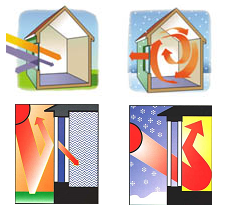
The glass system in any window greatly affects its overall energy performance. Since more than 80% of a window is made of glass, choosing the right package is crucial to the energy benefits you receive.
Improved comfort and lower energy consumption are greatly dependent on the insulating properties of your windows… and more importantly the type of glass used in those windows.
Glass Performance Comparisons:
(Please note these ratings are for illustration only; current glass options may vary so please ask your salesman for specifics.)
U-Value: Measures the rate of non-solar heat flow through the glass. The lower the U-Value the better.
Double Pane (Clear) 0.49
Low E/Argon* : 0.25
Triple Pane*: 0.10
R-Value: The inverse of a U-Value is a measure of the resistance of the glass to heat flow. The higher the R-Value the better.
Double Pane (Clear) 2.0
Low E/Argon* 4.0
Triple Pane* 10.0
*=Indicates an Energy Star rated product.
Glass Package Definitions:
1) Double Pane (Clear):
Two panes of glass sealed in an insulating glass unit
2) Low E/Argon:
Low E glass has been treated with an invisible metallic coating to make it act as a heat reflector.
One pane of Low E glass is combined with a pane of clear glass in an insulating glass unit. The air chamber is filled with Argon gas to increase the insulating value.
Argon is an inert gas that is odorless, colorless and completely safe. It is heavier than air, therefore heat and cold cannot pass through it as easily.
3) Triple Pane:
One pane of clear glass is sealed between two panes of Low E glass in an insulating glass unit.
The two air chambers are filled with Krypton gas to increase its insulating value.